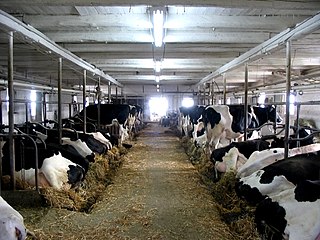
The Canadian Radio-television and Telecommunications Commission is a public organization in Canada with mandate as a regulatory agency for broadcasting and telecommunications. It was created in 1976 when it took over responsibility for regulating telecommunication carriers. Prior to 1976, it was known as the Canadian Radio and Television Commission, which was established in 1968 by the Parliament of Canada to replace the Board of Broadcast Governors. Its headquarters is located in the Central Building of Les Terrasses de la Chaudière in Gatineau, Quebec.

The North American Free Trade Agreement was an agreement signed by Canada, Mexico, and the United States that created a trilateral trade bloc in North America. The agreement came into force on January 1, 1994, and superseded the 1988 Canada–United States Free Trade Agreement between the United States and Canada. The NAFTA trade bloc formed one of the largest trade blocs in the world by gross domestic product.

Protectionism, sometimes referred to as trade protectionism, is the economic policy of restricting imports from other countries through methods such as tariffs on imported goods, import quotas, and a variety of other government regulations. Proponents argue that protectionist policies shield the producers, businesses, and workers of the import-competing sector in the country from foreign competitors; however, they also reduce trade and adversely affect consumers in general, and harm the producers and workers in export sectors, both in the country implementing protectionist policies and in the countries protected against.

The media of Canada is diverse and highly regionalized. News media, both print and digital and in both official languages, is largely dominated by a handful of major media corporations. The largest of these corporations is the country’s national public broadcaster, CBC/Radio-Canada, who also plays a significant role in producing domestic cultural content, operating radio and TV networks in both English and French.
Canadian content refers to the Canadian Radio-television and Telecommunications Commission (CRTC) requirements, derived from the Broadcasting Act of Canada, that radio and television broadcasters must produce and/or broadcast a certain percentage of content that was at least partly written, produced, presented, or otherwise contributed to by persons from Canada. CanCon also refers to that content itself, and, more generally, to cultural and creative content that is Canadian in nature.

The Canada–U.S. softwood lumber dispute is one of the largest and most enduring trade disputes between both nations. This conflict arose in 1982 and its effects are still seen today. British Columbia, the major Canadian exporter of softwood lumber to the United States, was most affected, reporting losses of 9,494 direct and indirect jobs between 2004 and 2009.
Simultaneous substitution is a practice mandated by the Canadian Radio-television and Telecommunications Commission (CRTC) requiring broadcast distribution undertakings (BDUs) in Canada to distribute the signal of a local or regional over-the-air station in place of the signal of a foreign or non-local television station, when the two stations are broadcasting identical programming simultaneously.
The Royal Commission on National Development in the Arts, Letters and Sciences, otherwise known as the Massey Commission, chaired by Vincent Massey, was founded in 1949. The Massey Commission examined Canada's cultural needs. Massey had long believed that Canadians' rich cultural history was deeply embedded in European culture but was too little known to the world. An avid art collector himself, he sponsored exhibits in Europe and saw the need for a national commitment to promoting the arts.

Television in Canada officially began with the sign-on of the nation's first television stations in Montreal and Toronto in 1952. As with most media in Canada, the television industry, and the television programming available in that country, are strongly influenced by media in the United States, perhaps to an extent not seen in any other major industrialized nation. As a result, the government institutes quotas for "Canadian content". Nonetheless, new content is often aimed at a broader North American audience, although the similarities may be less pronounced in the predominantly French-language province of Quebec.
Cultural exception is a political concept introduced by France in General Agreement on Tariffs and Trade (GATT) negotiations in 1993 to treat culture differently from other commercial products. In other words, its purpose is to consider cultural goods and services as exceptions in international treaties and agreements especially with the World Trade Organization (WTO). Its goals are to point out that States are sovereign as far as limitation of culture free trade is concerned in order to protect and promote their artists and other elements of their culture. Concretely, it can be seen through protectionist measures limiting the diffusion of foreign artistic work (quotas) or through subsidies distributed according to the country's cultural policy.
CKCL-FM is a commercial radio station in Winnipeg, Manitoba. Owned by Golden West Broadcasting, it broadcasts classical and jazz music.

The Broadcasting Act, given royal assent on 1 February 1991, is an act of the Parliament of Canada regarding broadcasting of telecommunications in the country.
The Royal Commission on Radio Broadcasting, otherwise known as the Aird Commission, was chaired by John Aird and examined Canada's broadcasting industry. The report released its findings in 1929 when it concluded that Canada was in need of a publicly funded radio broadcast system and a governing regulator for all broadcasting throughout the country. The Aird Report eventually resulted in the 1932 creation of the Canadian Radio Broadcasting Commission, the forerunner of the CBC as well as the CRTC.
This is a timeline of the history of the Canadian Broadcasting Corporation.
The trade relationship of the United States with Canada is the largest in the world. In 2016, the goods and services trade between the two countries totalled $627.8 billion. U.S. exports were $320.1 billion, while imports were $307.6 billion. The United States has a $12.5 billion trade surplus with Canada in 2016. Canada has historically held a trade deficit with the United States in every year since 1985 in net trade of goods, excluding services. The trade relationship between the two countries crosses all industries and is vitally important to both nations' success as each country is one of the largest trade partners of the other.

A commercial policy is a government's policy governing international trade. Commercial policy is an all encompassing term that is used to cover topics which involve international trade. Trade policy is often described in terms of a scale between the extremes of free trade on one side and protectionism on the other. A common commercial policy can sometimes be agreed by treaty within a customs union, as with the European Union's common commercial policy and in Mercosur. A nation's commercial policy will include and take into account the policies adopted by that nation's government while negotiating international trade. There are several factors that can have an impact on a nation's commercial policy, all of which can have an impact on international trade policies.
North American integration is the process of economic and political integration in North America, particularly integration of Canada, Mexico, and the United States.
Multicultural media in Canada, also referred to as “ethnic media” or “third media”, is media that responds to the needs of ethnic minorities of Canada. The objective of such media in Canada is to create a voice for a community of a particular ethnic background, challenge social injustices, and foster cultural pride for minority and immigrant Canadians.

Supply management, abbreviated SM, is a national agricultural policy framework used in Canada that controls the supply of dairy, poultry and eggs through production and import controls and pricing mechanisms. The supply management system was authorized by the 1972 Farm Products Agencies Act, which established the two national agencies that oversee the system. The Agriculture and Agri-Food Canada federal department is responsible for both the Canadian Dairy Commission and its analogue for eggs, chicken and turkey products, the Farm Products Council of Canada. Five national supply management organizations, the SM-5 Organizations — Egg Farmers of Canada (EFC), Turkey Farmers of Canada (TFC), Chicken Farmers of Canada (CFC), the Canadian Hatching Egg Producers (CHEP) and the Ottawa-based Canadian Dairy Commission (CDC), a Crown corporation — in collaboration with provincial and national governing agencies, organizations and committees, administer the supply management system.

Community radio in Canada is a legally defined broadcasting category governed by the Canadian Radio-television and Telecommunications Commission (CRTC). It is distinct from the other two categories, commercial broadcasting, and public broadcasting. Community radio can be considered a subcategory of alternative media. Community radio exists worldwide and is often broadly similar around the world, however, it can have variations in the government regulations that they are required to follow, the national or regional contexts in which its developed and the specific culture, goals or methods they adhere to.








